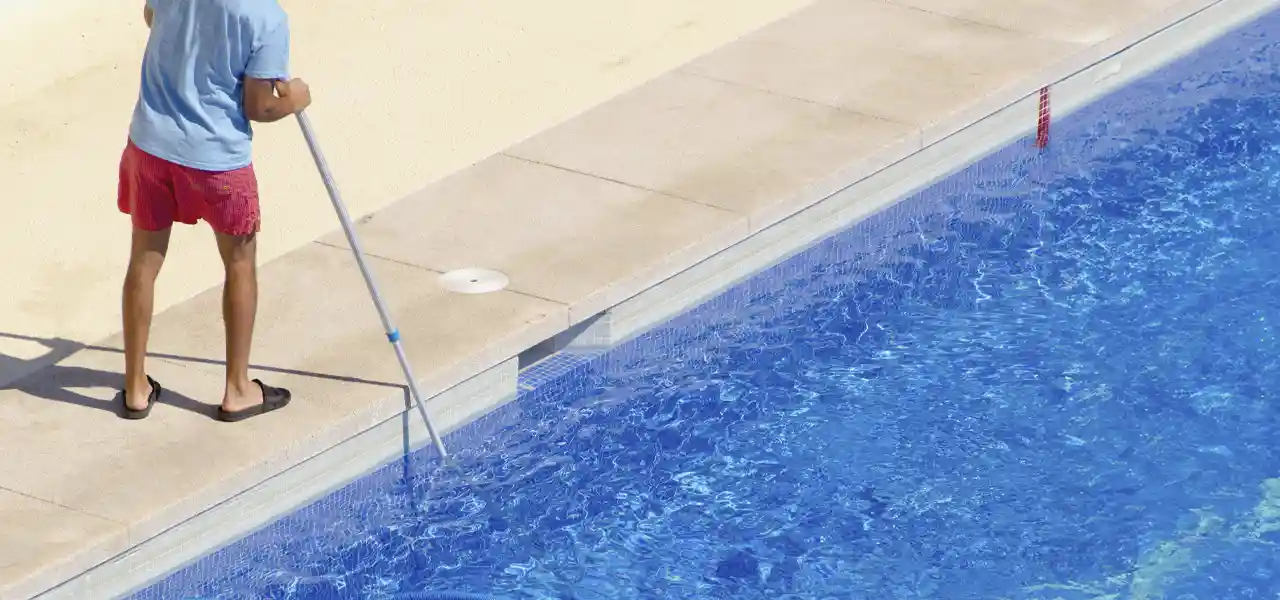FREE Standard Shipping On All Orders $100 or More!*

No Drain Pool Acid Wash
A no-drain acid wash is a term coined for a pool plaster cleaning or descaling process, without draining the pool water. Essentially, the pH of the pool water is reduced to a very acidic level of around 1.0, and an alkalinity level close to zero. Then the pool is brushed several times per day with a steel-bristled pool brush to loosen scale and dirt. After 3 days, the process is reversed, and the water chemistry returned to normal.
How Does a No Drain Acid Wash Work?

By lowering the pH and Total Alkalinity to such low levels, a corrosive water environment is created, which will slowly eat away at soft materials, like scale and stains. Such low pH can also continue to etch soft areas of plaster, however the no drain acid wash process only lasts for 3 days, and is reversed before (too much) damage can occur.
Not as good as a regular acid wash, which is a direct application of liquid acid to the plaster surface, to strip away a thin layer of plaster. A no drain acid wash is much less invasive, we are simply making the pool water very acidic. As such, results are good, but always less than a regular acid washing.
However, no drain acid wash is a popular alternative to draining the pool in areas with drought restrictions, limited well capacity or expensive city water supplies. In addition, regular acid washing is personally and environmentally hazardous, and can be quite expensive to have done.
Preparing for a No Drain Acid Wash
- Cool weather with clear skies ahead
- Over-filter and over-sanitize the pool in the week prior
- Clean pool very thoroughly, vacuum, brush and skim
- Remove all steel; ladders, rails, pool lights
- Remove pool cleaner and pool accessories
- Overfill pool to top of tile, or drain to bottom of tile
- Shut off pool pump and remove any timer ON trippers

Since the pool filter will be off for nearly a week, you want to do this during cool weather, and without storms or high winds, to keep the pool as clean as possible. It is helpful to over-filter the water by running the pump 24 hours per day for several days before a no drain acid wash. Additionally, shocking the pool heavily to remove organics and establish a high chlorine residual can help avoid cloudy water or algae growth. Algaecides can also be used.
Since the pool water will be very acidic, it's important to remove soft and shiny things from the pool, and keep the pump turned off during a no drain acid wash. PVC pipes and ABS pumps are fine with the low pH condition, but soft metals and rubbers used on pool equipment can be damaged if the pump runs for any length of time.
How to Complete a No Drain Acid Wash
Before you start a no-drain acid wash, be sure you are committed to the entire process and can apply each step of the daily process in a timely and complete fashion. This is a major swing in your pool water chemistry, so you must be able to commit to the process.
Chemical Usage and Doses
- Add 16 oz of Super Stain Away per 10,000 gallons
- Add 8 lbs of pH Decreaser (Sodium Bisulfate) per 5,000 gallons
- Check Total Alkalinity to be sure it's at zero; if not add more pH Decreaser
- Brush pool several times per day, with a steel pool brush, test water each day
- After 3 full days, begin to reverse the process, by raising pH and Alkalinity
- Add 8 lbs of pH Increaser (Soda Ash) per 5,000 gallons, in 3 equal doses
The Super Stain Away is an important step. Adjusting the pH and alkalinity to such low levels can precipitate minerals and metals, producing more problems. Use a quality sequestering agent to keep minerals locked in solution during the process.
Add the pH Decreaser evenly around the pool, distributing it as broadly as possible. Add it all at one time, and add more in areas with heavier staining. Brush the pool immediately afterward, and test the Total Alkalinity with a reliable test kit, to determine if the TA is actually 0 ppm (if not, add more pH Decreaser).
Add the pH Increaser in 3 separate doses, 6-12 hours apart, brushing the pool in between each addition. This is done to avoid clouding the pool water, for pools with high levels of Total Dissolved Solids, or TDS. However, don't be alarmed if you have temporary clouding of the water when adding the base, even with partial doses. Precipitated solids are mostly carbonates that will absorb and help to re-establish the Total Alkalinity.
Test your pH and Total Alkalinity again, and before you add the last several pounds of pH Increaser, so you don't raise pH and Alkalinity too high. Once your pH and Alkalinity levels have reestablished themselves as close to normal (pH: 7.2-7.6, TA: 80-120 ppm), you can turn the pump on again, and replace any removed items.
Follow-Up Advice for No Drain Acid Wash
- Add a Clarifier if needed, to help restore water sparkle and clarity faster.
- Test your water every day for a week. Returning pH and Total Alkalinity to normal levels can often require several repeat treatments.
- Proper Calcium Hardness level is also important to prevent scaling in pools. If below 180 ppm, add pool Hardness Increaser before starting the process.
- Continue to brush the pool every day with a steel bristled pool brush.
- Inspect your plaster closely each day while brushing. If excessive etching or rough areas appear, abort and reverse the process immediately.
- Do not shock the pool or add chlorine until pH and Alkalinity return to normal, but you can add a good algaecide if weather is warm or the water begins to turn.
No drain acid washing can be an easy alternative for some folks who cannot easily or cheaply refill a large plaster pool.